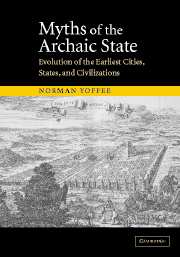Book contents
- Frontmatter
- Contents
- List of figures
- List of tables
- INTRODUCTION
- 1 THE EVOLUTION OF A FACTOID
- 2 DIMENSIONS OF POWER IN THE EARLIEST STATES
- 3 THE MEANING OF CITIES IN THE EARLIEST STATES AND CIVILIZATIONS
- 4 WHEN COMPLEXITY WAS SIMPLIFIED
- 5 IDENTITY AND AGENCY IN EARLY STATES: CASE STUDIES
- 6 THE COLLAPSE OF ANCIENT STATES AND CIVILIZATIONS
- 7 SOCIAL EVOLUTIONARY TRAJECTORIES
- 8 NEW RULES OF THE GAME
- 9 ALTERED STATES: THE EVOLUTION OF HISTORY
- Acknowledgments
- References
- Index
6 - THE COLLAPSE OF ANCIENT STATES AND CIVILIZATIONS
Published online by Cambridge University Press: 22 September 2009
- Frontmatter
- Contents
- List of figures
- List of tables
- INTRODUCTION
- 1 THE EVOLUTION OF A FACTOID
- 2 DIMENSIONS OF POWER IN THE EARLIEST STATES
- 3 THE MEANING OF CITIES IN THE EARLIEST STATES AND CIVILIZATIONS
- 4 WHEN COMPLEXITY WAS SIMPLIFIED
- 5 IDENTITY AND AGENCY IN EARLY STATES: CASE STUDIES
- 6 THE COLLAPSE OF ANCIENT STATES AND CIVILIZATIONS
- 7 SOCIAL EVOLUTIONARY TRAJECTORIES
- 8 NEW RULES OF THE GAME
- 9 ALTERED STATES: THE EVOLUTION OF HISTORY
- Acknowledgments
- References
- Index
Summary
There's a lot of ruin in a nation.
adam smith1988 was a banner year for the archaeological study of the “collapse” of ancient states and civilizations: two books on the subject appeared in that year, The Collapse of Complex Societies by Joseph Tainter (1988) and The Collapse of Ancient States and Civilizations, edited by George Cowgill and myself (Yoffee and Cowgill 1988). These books marked exceptions in social evolutionary theory, which was mainly concerned with the origin, development, and growth of particular states. Although I have criticized such studies as failing to explain the changes over time in social roles and the relations of domination, the proliferation of new, multiple, and overlapping identities in early urban communities, and the development of new ideologies of centralization, it is equally clear that discussion of the collapse of ancient states and civilizations, with the notable exceptions of the Maya and Roman cases, was, before 1988, conspicuous by its absence from the literature on social evolution.
The concern with rise, to the near exclusion of collapse, in social evolutionary studies, had important theoretical ramifications: social change was perceived as a process of mutually supportive interactions that produced an irreversible succession of levels of holistic sociocultural integration (Adams 1988). Studying collapse requires that levels be broken down into institutional groupings of partly overlapping and partly opposing fields of action that lend the possibility of instability, as well as stability, to overarching societal institutions.
- Type
- Chapter
- Information
- Myths of the Archaic StateEvolution of the Earliest Cities, States, and Civilizations, pp. 131 - 160Publisher: Cambridge University PressPrint publication year: 2005



